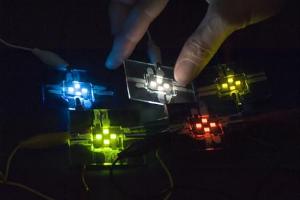Plexcore OC NQ Hole Injection Layer (HIL) ink from Plextronics has been integrated into P2OLED, a phosphorescent OLED solution from Universal Display.
The integration will help reduce operating voltage and extend the lifetime in test equipment. This is one of the latest advancements in Universal Display’s P2OLED program.
 P²OLED systems
P²OLED systems
The Plexcore OC NQ is a non-aqueous-based HIL ink developed mainly for phosphorescent OLED emitters that are solution processible. Plextronics’ high-performance ink was available in limited samples to the firm’s important partners and customers in October 2010.
Universal Display’s Senior Research Scientist, Dr. Kwang Ohk Cheon revealed the results of the Plexcore OC NQ HIL ink at IDMC. All results were obtained using the non-aqueous ink. The green P2OLED system now attains an operating lifetime of 175,000 h and provides a luminous efficiency of 68 cd/A, which is 1.3 times higher than the earlier results. The red P2OLED system provides an operating lifetime of 125,000 h and offers a luminous efficiency of 18 cd/A, which is twice higher in lifetime. Similarly, the light blue P2OLED system provides an operating lifetime of 8,000 h and provides a luminous efficiency of 29 cd/A, which is 1.8 times higher in terms of lifetime and luminous efficiency.
Universal Display announced these latest developments at the IDMC 2011 held in Taipei, Taiwan. Plextronics will continue to enhance its Plexcore OC NQ technology to produce ink-jet printable models that provide low voltage and extended life in printed OLEDs.